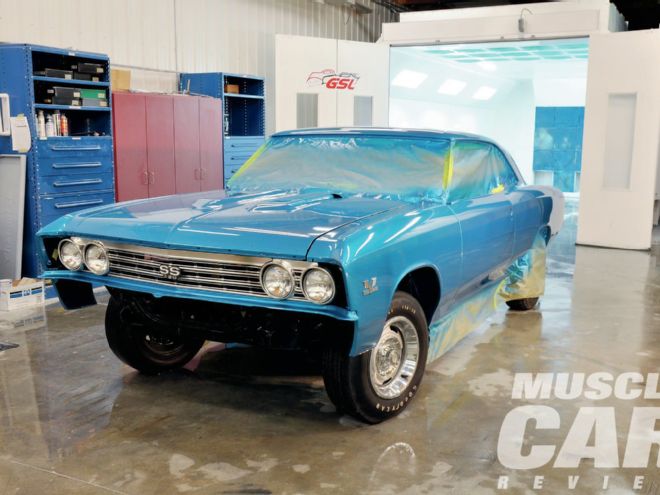
If it is time for you to get some paint on your muscle car, there are a number of decisions to be made. Examining a number of issues surrounding the paint job will make you more satisfied with the end product. You might even save some of your hard-earned cash.
The first issue is the simple question of whether you will paint the car yourself or have a pro do it. That question might be answered quickly by checking local ordinances. Is it legal to paint a car at your home? Even if it is legal, do you have neighbors who will come after you if they learn what you are doing? Things could get ugly in a hurry.
If you plan to paint the car yourself, do you have all the necessary equipment, or are you planning to make that purchase? Necessary equipment includes more than just a compressor and a paint gun. For example, any paint job requires dry air coming through the air lines to avoid "fish eyes," or small blisters in the paint. To have dry air you need a water separator for your compressor. Do you have one?
Your workplace must also be dry so the paint can lay on the car without issues. It also needs to be big enough to give you room for distance for the gun and proper material and vapor evacuation. Is your workplace sufficient not only for paintwork on your vehicle but also to hang the parts being painted? If you are planning to paint the car at home, will it be completely safe for your family?
For those who decide to have the car painted professionally, the big issue becomes choosing the right shop. Fortunately, that task is easier today than it was 20 years ago. Internet forums, car clubs, and word-of-mouth should help when choosing the proper shop. If you cannot name at least three shops that you would feel comfortable contracting for your paintwork, get busy and find those three shops. If you know of just one shop, you have no power to negotiate the compensation for services rendered.
The next issue involves the quality level of your restoration. Are you building a driver, an occasional local show winner, or a concours-level, best-in-the-country trailer queen? As you would imagine, the cost for a premium, award-winning paint job is exponentially higher than that for a driver-quality car.
A fourth issue involves choosing the paint system for your application. From my vantage point, there are basically five paint systems from which to choose. (For simplicity sake, this information is based on the PPG product line.)
First is old-school acrylic lacquer. Lead has been removed from acrylic lacquer, so lacquer is safer than it was 50 years ago. PPG refers to its (lead-free) lacquer as Duracryl. Acrylic lacquer is preferred by those who are committed to absolute restoration accuracy. Mike Ardito at Tri-Power Automotive in Libertyville, Illinois, works with Corvettes and unrestored original cars. Much of his work involves lacquer. Ardito notes that although lacquer is easy to paint, it must be buffed for shine, it is brittle, and it is not durable. Unless the car is religiously waxed and cared for, it will eventually begin to check or crack. Lacquer might help you win a concours event, but for most muscle car restorations, other choices make more sense.
The second system is acrylic enamel, what PPG calls Delstar. Delstar is a single-stage paint that does not need a clearcoat. Delstar is older technology and is only slightly more durable than lacquer. Where lacquer needs to be buffed out, Delstar will lay on with some gloss.
The third paint system is acrylic urethane, which PPG calls Concept. Acrylic urethane is a solvent-born single-stage paint that can be clearcoated; however, clearcoat is not necessary. Acrylic urethane offers excellent shine and durability. Concept paint can be made to look almost like a highly buffed lacquer. This paint is a great choice for solid color, nonmetallic muscle cars. It can be applied by the do-it-yourselfer with much success.
The fourth system is the solvent-born basecoat/clearcoat system PPG calls Deltron. Deltron is great for a deep shine and can be applied by the knowledgeable enthusiast. Deltron is an excellent choice for a muscle car featuring a metallic color. However, a downside to Deltron is the fact that it will present itself as better than the original paint of '60s and '70s muscle cars. For those who work with this paint frequently, some trade secrets with the clear can tone down the depth and shine of the paint.
The fifth system is the waterborne basecoat/clearcoat system. Waterborne (nonsolvent) paint is the wave of the future. PPG calls this system Envirobase. Envirobase paint meets or exceeds all current North American VOC regulations. In other words, it is more environmentally friendly than solvent-based paints. PPG claims superb metallic control. Many claim that colors of Envirobase paint are more vibrant. This system is not for the novice, but it is already showing up in a number of high-end restoration shops and collision repair shops.
With some of the above considerations fresh in your mind, follow along as Mike Goacher and his crew apply an acrylic urethane paint job to a very nice Marina Blue '67 Chevelle SS396 owned by Ron and Julie Krebs of Sabetha, Kansas. The results are typical of a reliable shop that cares for the customer.
1. Much of the body preparation is aided by a rotisserie. Access to the complete undercarriage is especially helpful. The undercarriage was stripped to bare metal. When all cleanup and prep was completed, the undercarriage was primed and painted body color.">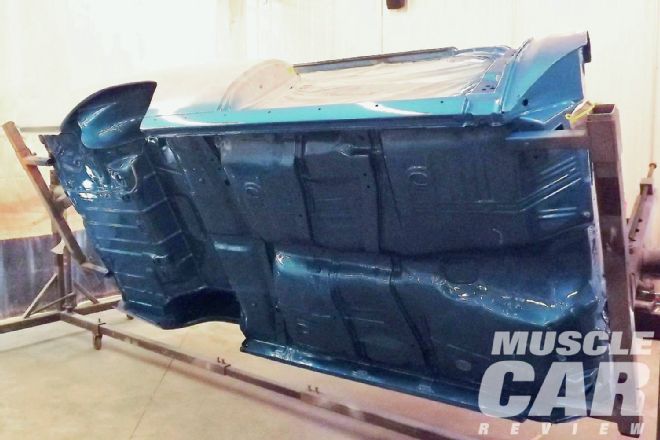 <strong>1</strong>. Much of the body preparation is aided by a rotisserie. Access to the complete undercarriage is especially helpful. The undercarriage was stripped to bare metal. When all cleanup and prep was completed, the undercarriage was primed and painted body color.
2. The chassis was completely restored and painted chassis black. Sporting all new bushings and body mounts, the body was lowered on the restored frame.">
<strong>1</strong>. Much of the body preparation is aided by a rotisserie. Access to the complete undercarriage is especially helpful. The undercarriage was stripped to bare metal. When all cleanup and prep was completed, the undercarriage was primed and painted body color.
2. The chassis was completely restored and painted chassis black. Sporting all new bushings and body mounts, the body was lowered on the restored frame.">
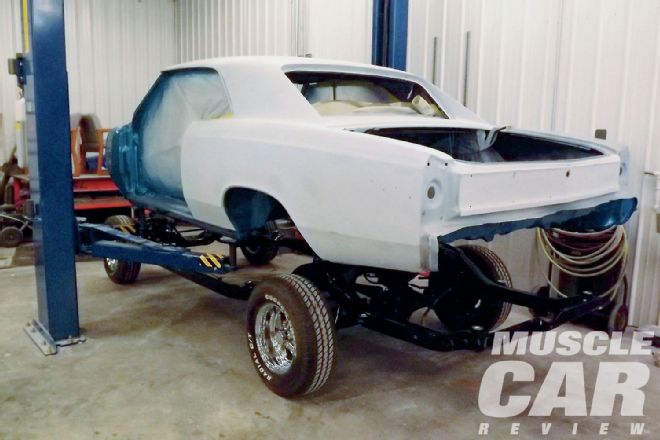 <strong>2</strong>. The chassis was completely restored and painted chassis black. Sporting all new bushings and body mounts, the body was lowered on the restored frame.
3. A lot of time was spent block sanding the car, which involved moving from coarse paper to a finer grit. Don Stone started with 220-grit paper, moved to 320, and then to 500 as he worked creating a perfectly straight and smooth surface. The best block-sanding technique is to sand in an X-pattern, allowing the paper to do the work.">
<strong>2</strong>. The chassis was completely restored and painted chassis black. Sporting all new bushings and body mounts, the body was lowered on the restored frame.
3. A lot of time was spent block sanding the car, which involved moving from coarse paper to a finer grit. Don Stone started with 220-grit paper, moved to 320, and then to 500 as he worked creating a perfectly straight and smooth surface. The best block-sanding technique is to sand in an X-pattern, allowing the paper to do the work.">
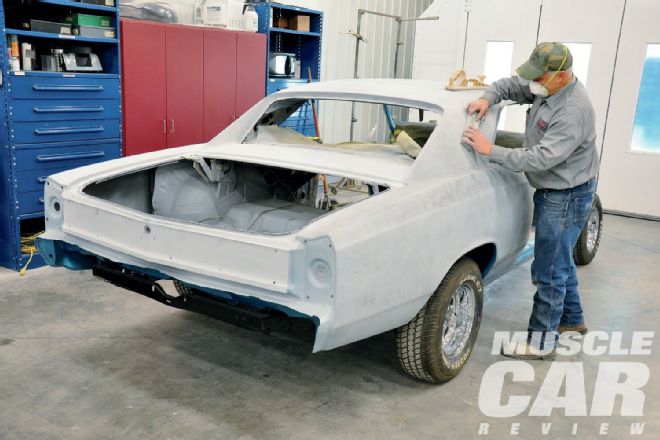 <strong>3</strong>. A lot of time was spent block sanding the car, which involved moving from coarse paper to a finer grit. Don Stone started with 220-grit paper, moved to 320, and then to 500 as he worked creating a perfectly straight and smooth surface. The best block-sanding technique is to sand in an X-pattern, allowing the paper to do the work.
4. A danger in block sanding is to overdo the sanding and round out the body lines. Tape was laid out at the body line to protect those edges.">
<strong>3</strong>. A lot of time was spent block sanding the car, which involved moving from coarse paper to a finer grit. Don Stone started with 220-grit paper, moved to 320, and then to 500 as he worked creating a perfectly straight and smooth surface. The best block-sanding technique is to sand in an X-pattern, allowing the paper to do the work.
4. A danger in block sanding is to overdo the sanding and round out the body lines. Tape was laid out at the body line to protect those edges.">
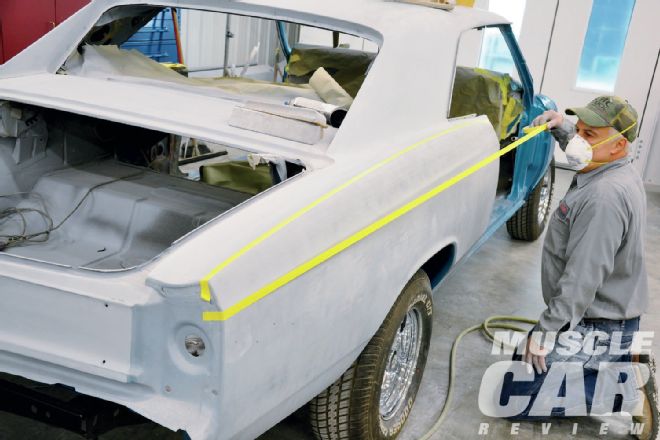 <strong>4</strong>. A danger in block sanding is to overdo the sanding and round out the body lines. Tape was laid out at the body line to protect those edges.
5. Stone masked the car in “hovercraft” style in order to keep overspray from hitting the undercarriage.">
<strong>4</strong>. A danger in block sanding is to overdo the sanding and round out the body lines. Tape was laid out at the body line to protect those edges.
5. Stone masked the car in “hovercraft” style in order to keep overspray from hitting the undercarriage.">
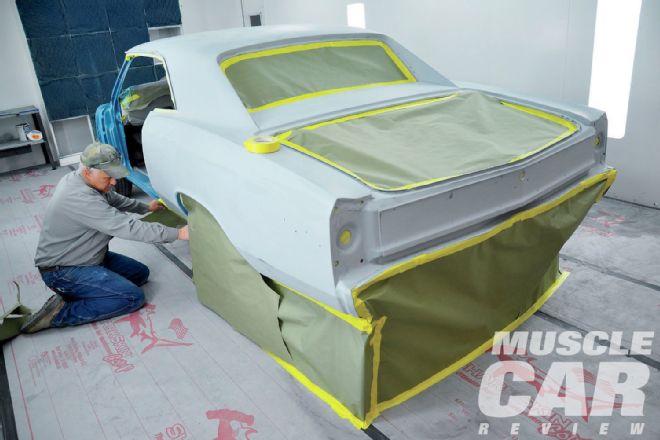 <strong>5</strong>. Stone masked the car in “hovercraft” style in order to keep overspray from hitting the undercarriage.
6. 3M two-part Auto Mix seam sealer was used to fill the dutchman panel seams. Only a very thin layer of seam sealer is necessary. To smooth the sealer, Mike Goacher uses his finger, occasionally dipping it in degreaser to keep the pattern consistent.">
<strong>5</strong>. Stone masked the car in “hovercraft” style in order to keep overspray from hitting the undercarriage.
6. 3M two-part Auto Mix seam sealer was used to fill the dutchman panel seams. Only a very thin layer of seam sealer is necessary. To smooth the sealer, Mike Goacher uses his finger, occasionally dipping it in degreaser to keep the pattern consistent.">
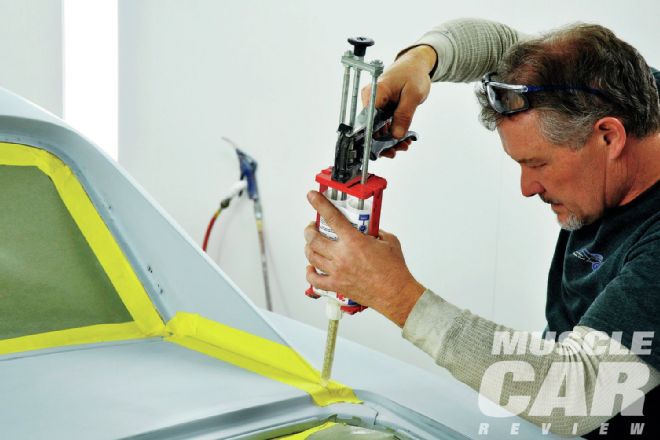 <strong>6</strong>. 3M two-part Auto Mix seam sealer was used to fill the dutchman panel seams. Only a very thin layer of seam sealer is necessary. To smooth the sealer, Mike Goacher uses his finger, occasionally dipping it in degreaser to keep the pattern consistent.
7. Every inch of the car must be cleaned with degreaser. Stone used this opportunity to feel for any imperfections in the body.">
<strong>6</strong>. 3M two-part Auto Mix seam sealer was used to fill the dutchman panel seams. Only a very thin layer of seam sealer is necessary. To smooth the sealer, Mike Goacher uses his finger, occasionally dipping it in degreaser to keep the pattern consistent.
7. Every inch of the car must be cleaned with degreaser. Stone used this opportunity to feel for any imperfections in the body.">
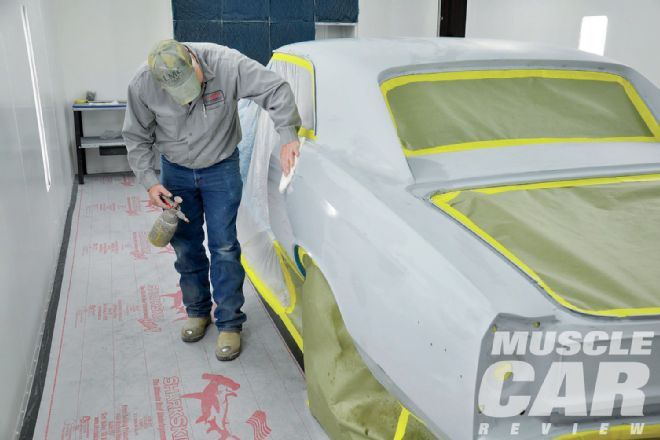 <strong>7</strong>. Every inch of the car must be cleaned with degreaser. Stone used this opportunity to feel for any imperfections in the body.
8. To apply the epoxy primer, Goacher used an Anest Iwata LPH400 spray gun. He says it produces a better pattern for an even application of the metallic in the paint. It’s shooting Shopline JP371 epoxy primer mixed with Shopline JR507 reducer. The JP371 serves as a sealer just prior to the application of color. The gun was set at 30 psi to produce a smooth foundation coat for the color. The JP371 then dried for about 25 minutes.">
<strong>7</strong>. Every inch of the car must be cleaned with degreaser. Stone used this opportunity to feel for any imperfections in the body.
8. To apply the epoxy primer, Goacher used an Anest Iwata LPH400 spray gun. He says it produces a better pattern for an even application of the metallic in the paint. It’s shooting Shopline JP371 epoxy primer mixed with Shopline JR507 reducer. The JP371 serves as a sealer just prior to the application of color. The gun was set at 30 psi to produce a smooth foundation coat for the color. The JP371 then dried for about 25 minutes.">
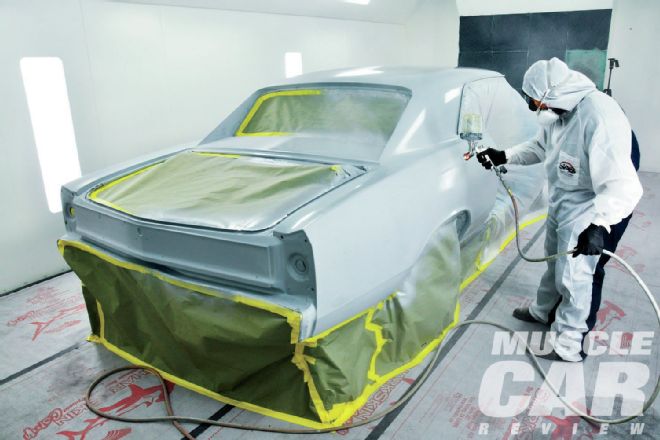 <strong>8</strong>. To apply the epoxy primer, Goacher used an Anest Iwata LPH400 spray gun. He says it produces a better pattern for an even application of the metallic in the paint. It’s shooting Shopline JP371 epoxy primer mixed with Shopline JR507 reducer. The JP371 serves as a sealer just prior to the application of color. The gun was set at 30 psi to produce a smooth foundation coat for the color. The JP371 then dried for about 25 minutes.
9. To put color on the car, Goacher used a Shopline acrylic urethane basecoat and followed with three coats of Shopline clearcoat for depth and gloss. The Marina Blue basecoat was applied from the top down. For the first two coats of color, the spray gun was set at 28 psi.">
<strong>8</strong>. To apply the epoxy primer, Goacher used an Anest Iwata LPH400 spray gun. He says it produces a better pattern for an even application of the metallic in the paint. It’s shooting Shopline JP371 epoxy primer mixed with Shopline JR507 reducer. The JP371 serves as a sealer just prior to the application of color. The gun was set at 30 psi to produce a smooth foundation coat for the color. The JP371 then dried for about 25 minutes.
9. To put color on the car, Goacher used a Shopline acrylic urethane basecoat and followed with three coats of Shopline clearcoat for depth and gloss. The Marina Blue basecoat was applied from the top down. For the first two coats of color, the spray gun was set at 28 psi.">
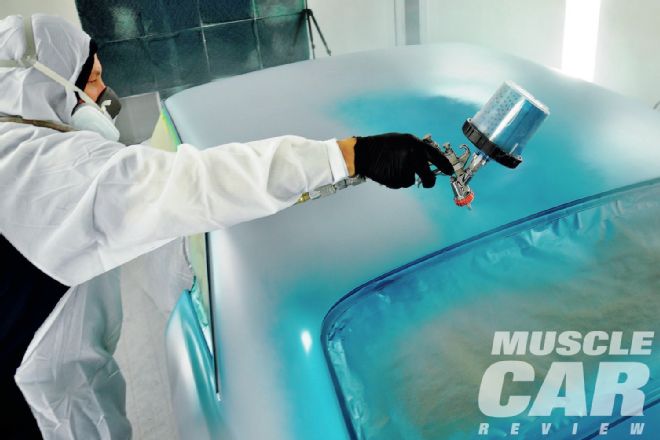 <strong>9</strong>. To put color on the car, Goacher used a Shopline acrylic urethane basecoat and followed with three coats of Shopline clearcoat for depth and gloss. The Marina Blue basecoat was applied from the top down. For the first two coats of color, the spray gun was set at 28 psi.
10. Goacher’s safety equipment includes a respirator, a full body suit, and gloves.">
<strong>9</strong>. To put color on the car, Goacher used a Shopline acrylic urethane basecoat and followed with three coats of Shopline clearcoat for depth and gloss. The Marina Blue basecoat was applied from the top down. For the first two coats of color, the spray gun was set at 28 psi.
10. Goacher’s safety equipment includes a respirator, a full body suit, and gloves.">
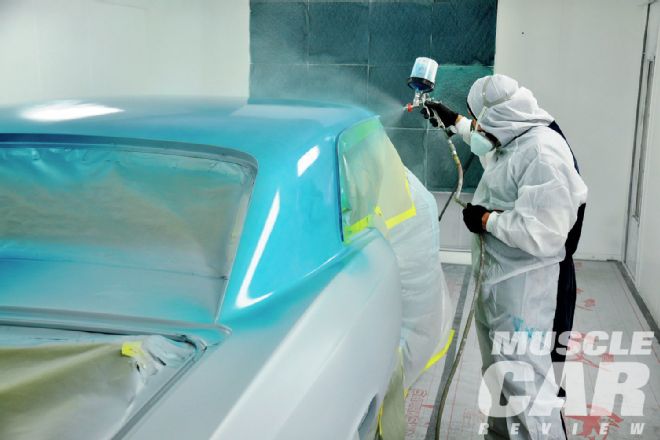 <strong>10</strong>. Goacher’s safety equipment includes a respirator, a full body suit, and gloves.
11. Note this photo, of the first coat of paint, shows the paint is not completely covering the panels. The first coat should be light; laying it on too thick could cause runs or unevenness.">
<strong>10</strong>. Goacher’s safety equipment includes a respirator, a full body suit, and gloves.
11. Note this photo, of the first coat of paint, shows the paint is not completely covering the panels. The first coat should be light; laying it on too thick could cause runs or unevenness.">
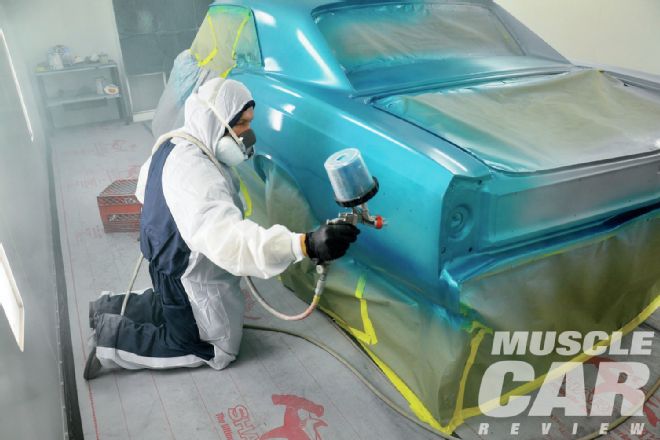 <strong>11</strong>. Note this photo, of the first coat of paint, shows the paint is not completely covering the panels. The first coat should be light; laying it on too thick could cause runs or unevenness.
12. Goacher applied three coats of color. The third coat is called a drop coat, where he cranks the air in the gun to 32 psi and reduces the volume of material. Those adjustments result in a more even coat of metallic, avoiding any blotchiness in the paint.">
<strong>11</strong>. Note this photo, of the first coat of paint, shows the paint is not completely covering the panels. The first coat should be light; laying it on too thick could cause runs or unevenness.
12. Goacher applied three coats of color. The third coat is called a drop coat, where he cranks the air in the gun to 32 psi and reduces the volume of material. Those adjustments result in a more even coat of metallic, avoiding any blotchiness in the paint.">
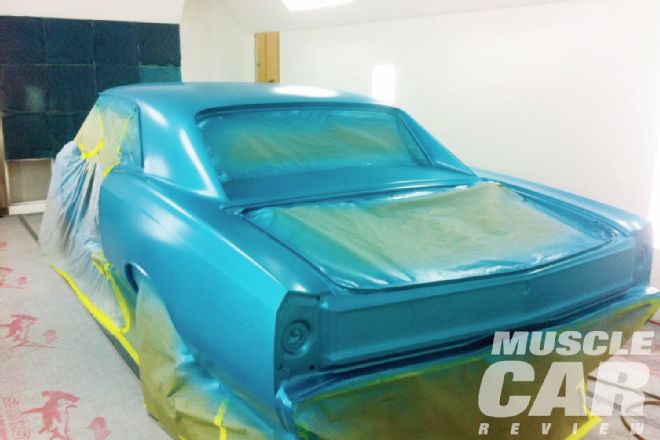 <strong>12</strong>. Goacher applied three coats of color. The third coat is called a drop coat, where he cranks the air in the gun to 32 psi and reduces the volume of material. Those adjustments result in a more even coat of metallic, avoiding any blotchiness in the paint.
13. The doors were laid out separately from the body and were painted along the edges and on the interior side.">
<strong>12</strong>. Goacher applied three coats of color. The third coat is called a drop coat, where he cranks the air in the gun to 32 psi and reduces the volume of material. Those adjustments result in a more even coat of metallic, avoiding any blotchiness in the paint.
13. The doors were laid out separately from the body and were painted along the edges and on the interior side.">
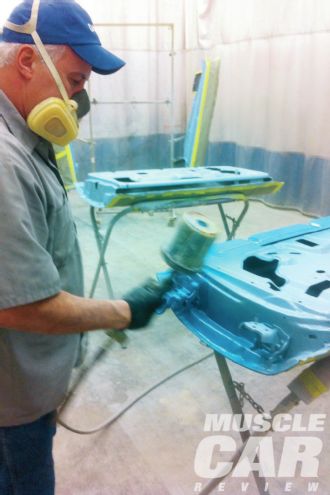 <strong>13</strong>. The doors were laid out separately from the body and were painted along the edges and on the interior side.
14. Likewise, the trunk was edged and painted basecoat color on the backside.">
<strong>13</strong>. The doors were laid out separately from the body and were painted along the edges and on the interior side.
14. Likewise, the trunk was edged and painted basecoat color on the backside.">
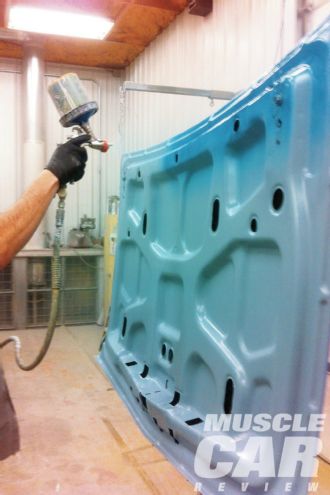 <strong>14</strong>. Likewise, the trunk was edged and painted basecoat color on the backside.
15. Goacher changed spray guns when he applied the clear. His choice was an Anest Iwata Super Nova set at 34 psi. The Super Nova gun is known for efficient atomization and a stronger spray pattern, which are important for proper clearcoat application.">
<strong>14</strong>. Likewise, the trunk was edged and painted basecoat color on the backside.
15. Goacher changed spray guns when he applied the clear. His choice was an Anest Iwata Super Nova set at 34 psi. The Super Nova gun is known for efficient atomization and a stronger spray pattern, which are important for proper clearcoat application.">
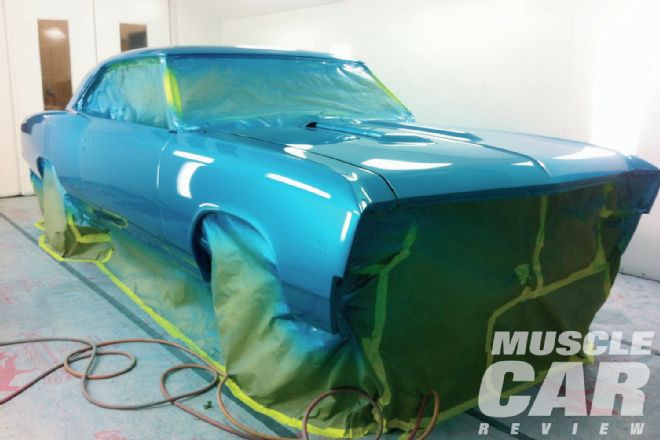 <strong>15</strong>. Goacher changed spray guns when he applied the clear. His choice was an Anest Iwata Super Nova set at 34 psi. The Super Nova gun is known for efficient atomization and a stronger spray pattern, which are important for proper clearcoat application.
<strong>15</strong>. Goacher changed spray guns when he applied the clear. His choice was an Anest Iwata Super Nova set at 34 psi. The Super Nova gun is known for efficient atomization and a stronger spray pattern, which are important for proper clearcoat application.